
Messier 83 or M83, also known as the Southern Pinwheel Galaxy and NGC 5236, is a barred spiral galaxy approximately 15 million light-years away in the constellation borders of Hydra and Centaurus. Nicolas-Louis de Lacaille discovered M83 on 17 February 1752 at the Cape of Good Hope. Charles Messier added it to his catalogue of nebulous objects in March 1781.

Messier 59 or M59, also known as NGC 4621, is an elliptical galaxy in the equatorial constellation of Virgo. It is a member of the Virgo Cluster, with the nearest fellow member 8′ away and around 5 magnitudes fainter. The nearest cluster member of comparable brightness is the lenticular galaxy NGC 4638, which is around 17′ away. It and the angularly nearby elliptical galaxy Messier 60 were both discovered by Johann Gottfried Koehler in April 1779 when observing comet seeming close by. Charles Messier listed both in the Messier Catalogue about three days after Koehler's discovery.
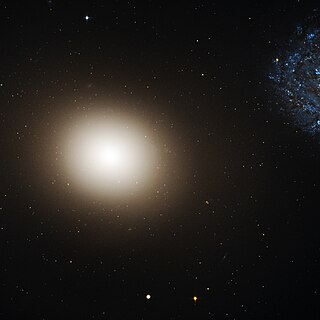
Messier 60 or M60, also known as NGC 4649, is an elliptical galaxy approximately 57 million light-years away in the equatorial constellation of Virgo. Together with NGC 4647, it forms a pair known as Arp 116. Messier 60 and nearby elliptical galaxy Messier 59 were discovered by Johann Gottfried Koehler in April 1779, observing a comet in the same part of the sky. Charles Messier added both to his catalogue about three days after this.
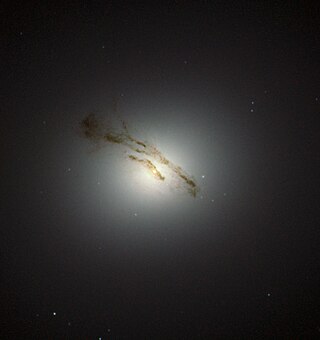
Messier 84 or M84, also known as NGC 4374, is a giant elliptical or lenticular galaxy in the constellation Virgo. Charles Messier discovered the object in 1781 in a systematic search for "nebulous objects" in the night sky. It is the 84th object in the Messier Catalogue and in the heavily populated core of the Virgo Cluster of galaxies, part of the local supercluster.

Messier 105 or M105, also known as NGC 3379, is an elliptical galaxy 36.6 million light-years away in the equatorial constellation of Leo. It is the biggest elliptical galaxy in the Messier catalogue that is not in the Virgo cluster. It was discovered by Pierre Méchain in 1781, just a few days after he discovered the nearby galaxies Messier 95 and Messier 96. This galaxy is one of a few not object-verified by Messier so omitted in the editions of his Catalogue of his era. It was appended when Helen S. Hogg found a letter by Méchain locating and describing this object which matched those aspects under its first-published name, NGC 3379.

NGC 1316 is a lenticular galaxy about 60 million light-years away in the constellation Fornax. It is a radio galaxy and at 1400 MHz is the fourth-brightest radio source in the sky.

NGC 5253 is an irregular galaxy in the constellation Centaurus. It was discovered by William Herschel on 15 March 1787.

NGC 4536 is an intermediate spiral galaxy in the constellation Virgo. It was discovered by German-British astronomer William Herschel on 24 January 1784.
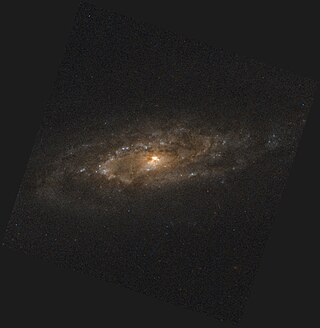
NGC 7537 is a spiral galaxy located in the equatorial constellation of Pisces, about 1.5° to the NNW of Gamma Piscium. It was first documented by German-born astronomer William Herschel on Aug 30, 1785. J. L. E. Dreyer described it as, "very faint, considerably small, round, brighter middle, southwestern of 2". This galaxy lies at a distance of approximately 127 Mly (39 Mpc) from the Milky Way, and is a member of the Pegasus I cluster.

NGC 3169 is a spiral galaxy about 75 million light years away in the constellation Sextans. It has the morphological classification SA(s)a pec, which indicates this is a pure, unbarred spiral galaxy with tightly-wound arms and peculiar features. There is an asymmetrical spiral arm and an extended halo around the galaxy. It is a member of the NGC 3166 Group of galaxies, which is a member of the Leo II Groups, a series of galaxies and galaxy clusters strung out from the right edge of the Virgo Supercluster.
The Eridanus Group, sometimes called the Eridanus Cloud, is a nearby loose grouping of galaxies at a mean distance of approximately 75 Mly in the constellation Eridanus. Redshift values show that there are approximately 200 galaxies associated with the group, approximately 70% of which are spiral and irregular type galaxies while the remaining 30% are elliptical and lenticular types.
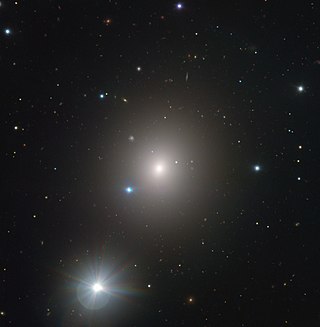
NGC 1404 is an elliptical galaxy in the Southern constellation Eridanus. It was discovered on November 28, 1837, by the astronomer John Herschel. Based on the tip of the red-giant branch distance indicator, it lies at a distance of approximately 60 million light-years from the Milky Way. It is one of the brightest members of the Fornax Cluster.
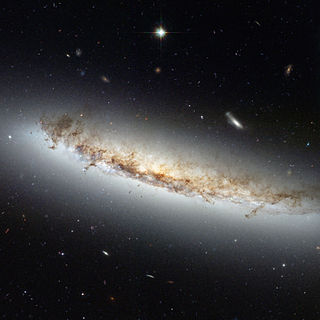
NGC 4402 is a relatively near, edge-on spiral galaxy located around 50 million light-years from Earth. It is in the constellation of Virgo within the Virgo Cluster of galaxies. It can be seen when viewing Markarian's Chain.
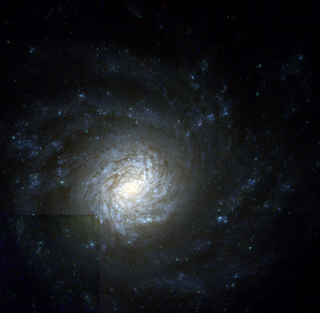
NGC 4041 is the New General Catalogue identifier for a spiral galaxy in the northern circumpolar constellation of Ursa Major. It is located an estimated 70 million light years from the Sun. The morphological classification of SA(rs)bc indicates this is a spiral galaxy the lacks a bar; the 'rs' means it has a weakly-formed ring structure, and the 'bc' indicates the spiral arms are moderately to loosely wound.

NGC 1084 is an unbarred spiral galaxy in the constellation Eridanus. It is located at a distance of about 63 million light-years away from the Milky Way. The galaxy was discovered by William Herschel on 10 January 1785. It has multiple spiral arms, which are not well defined. It belongs in the same galaxy group with NGC 988, NGC 991, NGC 1022, NGC 1035, NGC 1042, NGC 1047, NGC 1052 and NGC 1110. This group is in turn associated with the Messier 77 group.

NGC 1407 is an elliptical galaxy in Eridanus. It is at a distance of 76 million light-years from Earth. It is the brightest galaxy in the NGC 1407 Group, part of the Eridanus Group, with NGC 1407 being its brightest member. NGC 1400, the second-brightest of the group lies 11.8 arcmin away.

NGC 3610 is an elliptical galaxy in the constellation Ursa Major. It was discovered on 8 April 1793 by German-British astronomer William Herschel. This galaxy is located at a distance of 106 million light-years (32.5 Mpc) from the Milky Way, and is receding with a galacto-centric radial velocity of 1,819 km/s.

NGC 759 is an elliptical galaxy located 230 million light-years away in the constellation Andromeda. NGC 759 was discovered by astronomer by Heinrich d'Arrest on September 17, 1865. It is a member of Abell 262.
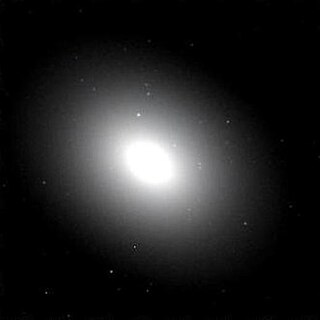
NGC 4365 is an elliptical galaxy located in the constellation Virgo. It was discovered by William Herschel on April 13, 1784.

NGC 3613 is an elliptical galaxy in the constellation Ursa Major. It was discovered by the astronomer William Herschel on April 8, 1793. NGC 3613 is the center of a cluster of galaxies, and has an estimated globular cluster population of over 2,000.





















